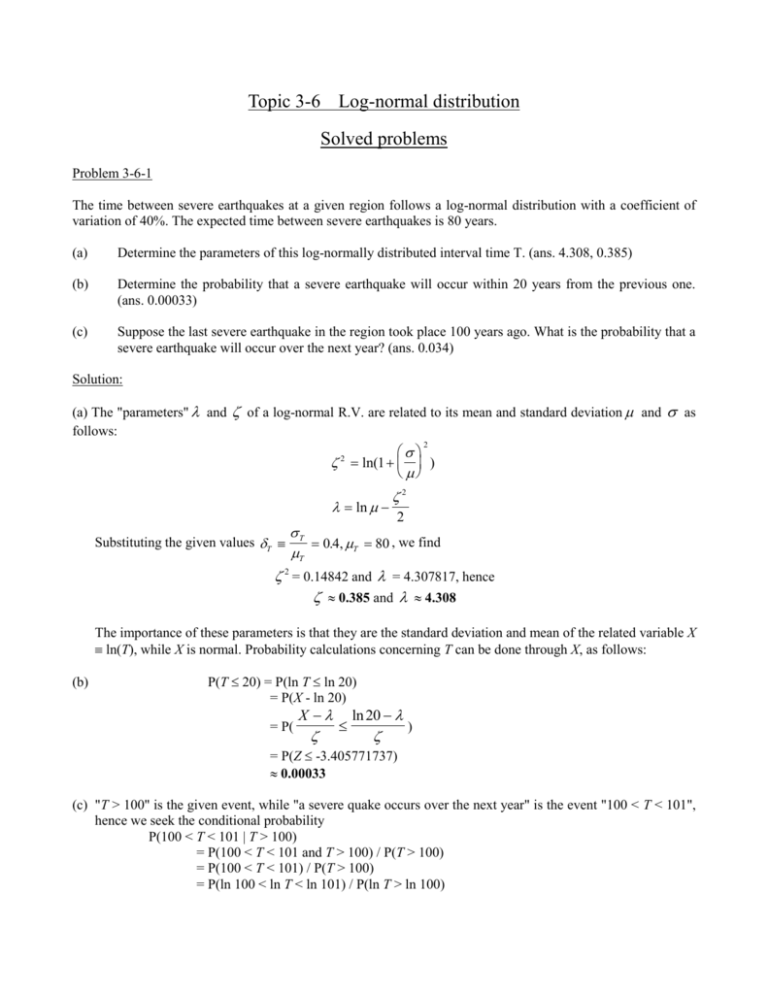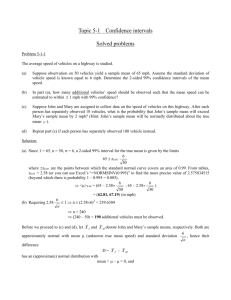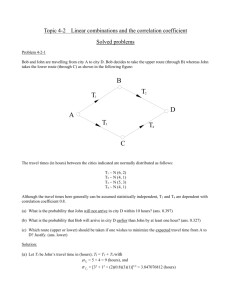The log-normal distribution
advertisement

Topic 3-6 Log-normal distribution Solved problems Problem 3-6-1 The time between severe earthquakes at a given region follows a log-normal distribution with a coefficient of variation of 40%. The expected time between severe earthquakes is 80 years. (a) Determine the parameters of this log-normally distributed interval time T. (ans. 4.308, 0.385) (b) Determine the probability that a severe earthquake will occur within 20 years from the previous one. (ans. 0.00033) (c) Suppose the last severe earthquake in the region took place 100 years ago. What is the probability that a severe earthquake will occur over the next year? (ans. 0.034) Solution: (a) The "parameters" and of a log-normal R.V. are related to its mean and standard deviation and as follows: ln(1 ) 2 2 ln 2 2 T Substituting the given values T 0.4, T 80 , we find T 2 = 0.14842 and = 4.307817, hence 0.385 and 4.308 The importance of these parameters is that they are the standard deviation and mean of the related variable X ln(T), while X is normal. Probability calculations concerning T can be done through X, as follows: (b) P(T 20) = P(ln T ln 20) = P(X - ln 20) = P( X ln 20 ) = P(Z -3.405771737) 0.00033 (c) "T > 100" is the given event, while "a severe quake occurs over the next year" is the event "100 < T < 101", hence we seek the conditional probability P(100 < T < 101 | T > 100) = P(100 < T < 101 and T > 100) / P(T > 100) = P(100 < T < 101) / P(T > 100) = P(ln 100 < ln T < ln 101) / P(ln T > ln 100) = P( ln 100 = [P( Z X ln101 ln 101 ) P(Z < ) / P( ln100 X ) ] / [1 P( ln100 X ) ln 100 )] = (0.787468 0.779895) / (1 0.779895) 0.034 Problem 3-6-2 The daily average concentration of pollutants in a stream follows a log-normal distribution with a mean of 60 mg/l and a c.o.v. of 20%. (a) What is the probability that the average concentration of pollutant in the stream would exceed 100 mg/l (a critical level) on a given day? (ans. 0.00398) (b) Suppose the pollutant concentration between days are statistically independent. What is the probability that the critical level of pollutant concentration will not be reached during a given week? (ans. 0.972) Solution: (a) Let X be the daily average pollutant concentration. The parameters of X are: = 0.2, ln 60 – 0.22 / 2 4.074 Hence P(X > 100) = 1 – P(X 100) = 1 – ( ln 100 4.074344562 ) 0.2 = 1 – (2.654128119) = 1 – 0.996024276 0.00398 (b) Let Y be the total number of days on which critical level is reached during a given week. Y follows a binomial distribution with parameters n = 7, p = 0.003975724 (and 1 – p = 0.996024276), hence the required probability is P(Y = 0) = 0.9960242767 0.972 Problem 3-6-3 A student has submitted a concrete cylinder to the concrete cylinder strength contest at the Engineering Open House. From her previous experiences, she believes that her cylinder strength will be normally distributed as N(1000, 200) in pounds. She was scheduled to be the last contestant for load testing. Right before her cylinder is tested, she observed that the two highest strengths in the contest up to that point are 1200 and 1100 lbs. respectively. (a) What is her estimated probability of being the first place winner? (ans. 0.159) (b) What is her estimated probability of being the second place winner? (ans. 0.150) (c) How would the probability in part (a) change if she believes that her cylinder strength is log-normally distributed instead? The mean and standard deviation are still 1000 and 200 lbs. (ans. 0.156) Solution: Let X be the student’s cylinder strength. (a) To be the first place winner, her cylinder strength must beat the current highest, hence the required probability is X 1200 1000 P(X > 1200) = P( > ) 20 = 1 – (1) 0.159 (b) To be in second place, her cylinder strength must be somewhere in between the currently highest and second highest strengths, hence the required probability is 1100 1000 X 1200 1000 P(1100 < X < 1200) = P( < < ) 20 20 = (1) – (0.5) = 0.84134474 – 0.691462467 0.150 (c) If X were log-normally distributed with mean 1000 and standard deviation 200, which gives a COV of 0.2, the parameters are = 0.2, ln(1000) – 0.22 / 2 = 6.887755279, hence the probability becomes ln X ln 1200 6.88775527 9 P(X > 1200) = P( > ) 0.2 = 1 – (1.011607784) 0.156 Exercises Exercise 3-6-1 The capacity of a pile supporting a transmission tower is described by a log-normal random variable with a mean of 100 tons a c.o.v. of 20%. (a) What is the probability that the pile will survive a load of 100 tons? (b) Suppose the maximum load applied to this pile during an expected operation period of 50 years is lognormally distributed with a mean of 50 tons and a standard deviation of 15 tons. What is the probability of failure of this pile? (c) During the installation of the pile, pile driving record indicated that the pile can support at least a load of 75 tons. What is now the probability that the pile will survive a 100-ton load? (d) If the pile has survived a recent hurricane during which the load transmitted to the pile is estimated to be 90 tons, what is now the probability that the pile will survive a 100-ton load? Exercise 3-6-2 The maximum wind velocity in a tornado at a given city follows a log-normal distribution with a mean of 90 mph and a c.o.v. of 20%. (a) What is the probability that the maximum wind velocity will exceed 120 mph during the next tornado? (b) Determine the design tornado wind velocity whose return period is 100 years. Assume one tornado will attack this city each year. Exercise 3-6-3 A water distribution network is shown as follows: A City B For a given rate of flow through the network, the performance at a given node is measured by the head pressure at the node. Satisfactory performance at a node requires that its pressure be within a normal range, say between 6 and 14 units. Suppose the pressure at node A is a log-normal random variable with a mean value of 10 and a c.o.v. of 20%. (a) What is the probability of satisfactory performance at node A? (ans. 0.955) (b) Suppose a city is served by nodes A and B. Ordinarily, the pressure at B has a 90% probability of falling within the normal range. However, the pressure at B is dependent on the pressure at A. In the event that the pressure at A falls outside of the normal range, the pressure at B will fall outside of the normal range with twice its ordinary probability. Satisfactory water service to the city requires that at least one of the nodes A or B has normal water pressure. What is the probability of unsatisfactory water service to the city? (ans. 0.0089) (c) Suppose resources are available to improve the water-distribution sysems by either one of the following options: (I) reduce the c.o.v. of pressure at A to 15%, or (II) increase the ordinary probability of pressure at B within the normal range to 95%. Which option is better in terms of minimizing the probability of unsatisfactory water service to the city? (ans. I)









